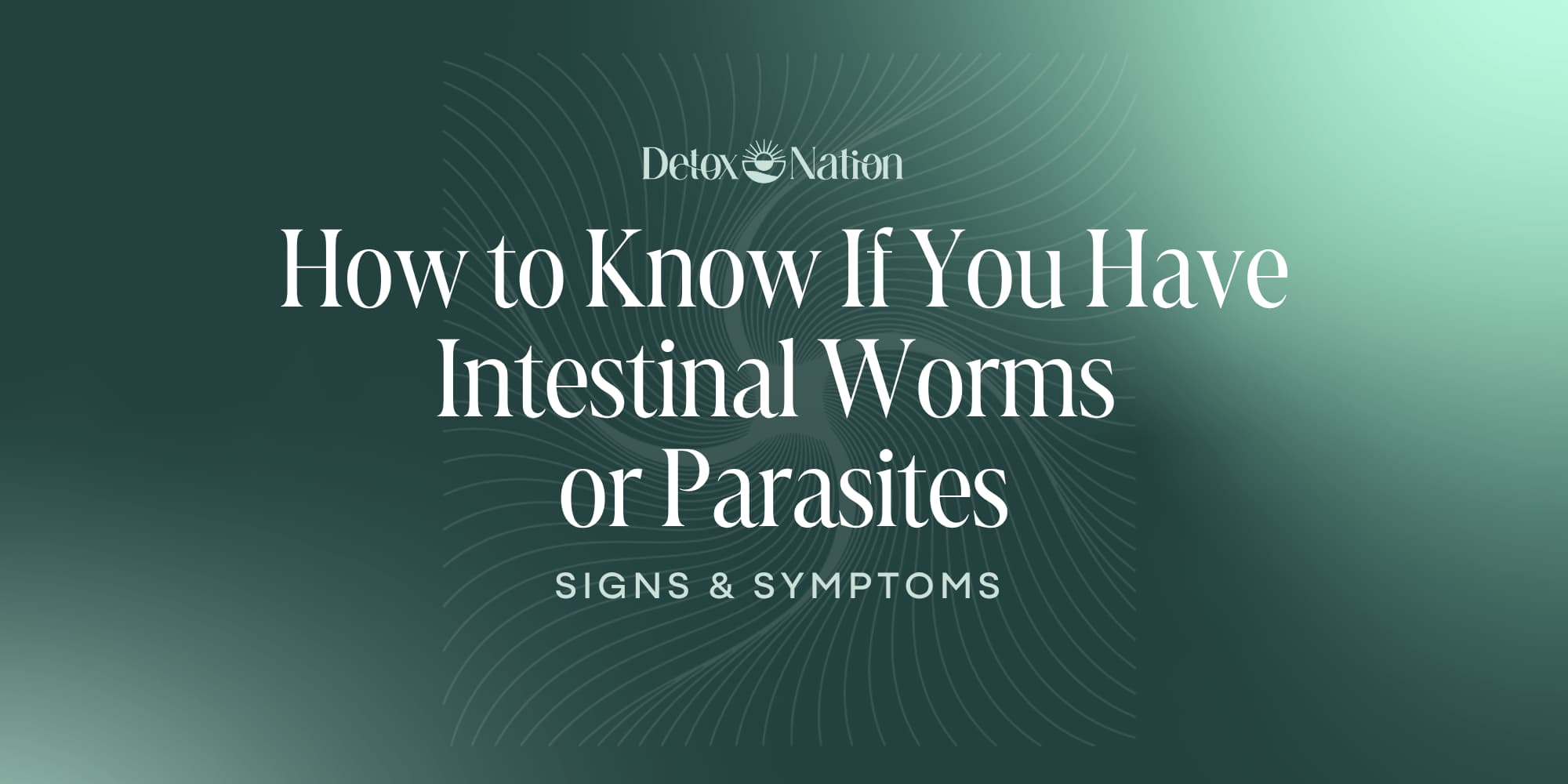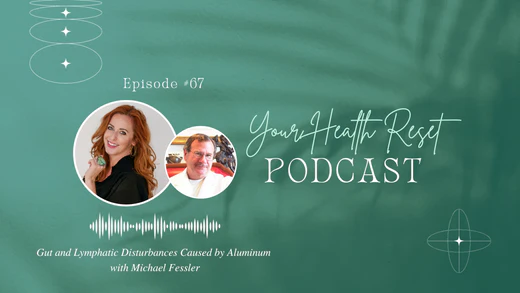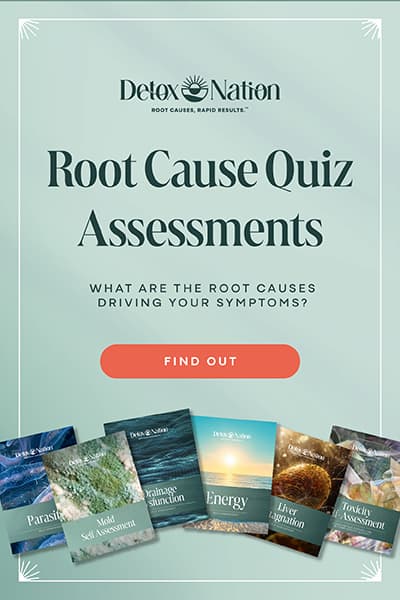Did you know that intestinal worms and intestinal parasites can cause a range of chronic health symptoms? Worms in humans include more than just pinworms and tapeworms. Let’s take a look!
Ever had an itch that makes you want to rip your skin off? Yeah, me too. But if that itch keeps coming back, especially at night, it’s time to stop blaming your detergent and think bigger—like, worm bigger.
I know, it sounds like something out of a horror movie, but parasitic infections are a very real, and very fixable, problem.
And if you’ve been feeling run down for a while—fatigued, bloated, or stuck in a bathroom drama—you might have a few unwanted guests freeloading in your gut.
Worm infections are more common than you might think, and they’re not just something that happens in far-off places.
People from all walks of life can get worms, thanks to factors like travel, pets, or even contaminated food.
Many times, symptoms are subtle, making it easy for people to overlook them.
But before you start thinking you’re doomed to be a walking worm hotel, let’s break down the symptoms and review how to know if you have worms in your stool.
Trust me, it’s better to know now than to keep guessing.
Key Takeaways
- Worm infections are more common than you realize.
- Worms could be behind your chronic symptoms.
- These infections are fixable – you don’t have to be a waking worm hotel!
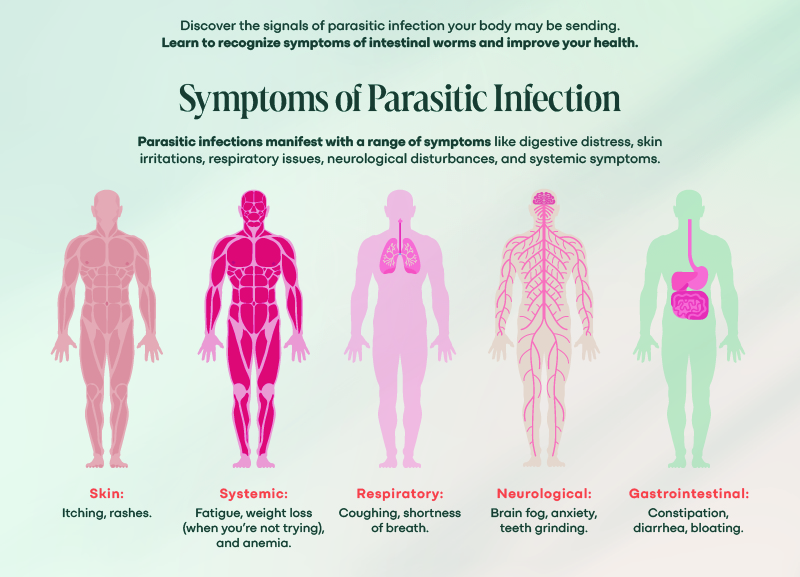
Recognizing the Symptoms of Intestinal Worm Infection
When you have worms, your body might show different clues. These alerts can affect your skin, digestion, and overall, how you feel day-to-day.
Physical Indicators
Rashes, hives, and itching are common physical signs of parasitic infection (1, 2).
The persistent rashes or hives can be so bad they make you want to tear your skin off.
One particular torment is when you’re itching and scratching and unable to sleep due to hives – but it continues for longer than six weeks (3). Think parasites!
Some worm infections cause crazy-intense itching (especially around the anus) that can be worse at night because some worms lay eggs then.
You might have heard you can spread the worms to your perianal or even vulvovaginal areas by scratching.
But did you know female pinworms have been found in the kidneys, bladder, lungs, vagina, and ovaries (4)!
Sometimes, you can see visible worms in your stool.
Another sign of parasites is unexplained weight loss.
Worms can leach nutrients from your body, leading to weight loss even if your eating habits haven’t changed.
Fatigue and teeth grinding are also possible, showing your body is stressed by the infection (5).
The next step?
Take my quick Parasite Assessment Quiz to see if squirmin’ worms might be causing your chronic symptoms.
Take the Parasite Quiz NowDigestive Disturbances
Digestive issues are common with parasites.
As they invade your gut, parasites cause inflammation and dysbiosis – an imbalance in the “good” and “bad” bacteria in your gut (6, 7).
You could experience nausea, vomiting, abdominal pain or discomfort as gas and bloating that make you reach for your baggy pants.
If the parasites set up shop in your liver, you could have pain in your upper right abdomen. (Parasites in the liver, such as liver flukes, can cause dangerous blockages and even cancer (8).)
As the parasites make themselves at home in your gut, they degrade your protective mucosal lining and set the stage for leaky gut (9).
They also suppress your immune system, the devious little mooches!
Diarrhea, constipation, food sensitivities, or bladder disturbances are other issues that keep you close to the bathroom as your systems are in an uproar (10).

Impact on General Well-being
A parasitic infection makes you feel tired or worn out as your weakened immune system continues to battle the invaders.
Some other general symptoms can include:
- Mood changes, like anxiety or depression (11) as the parasites hijack your neurotransmitters and hormonal pathways (15)
- Nutritional deficiencies that can result in other problems such as iron-deficiency anemia (12).
- Insomnia or restlessness (13)
- Poor night vision can occur as the worms steal Vitamin A, vital for eye health (14)
- Development of liver and kidney stones, reducing efficiency of these important detox organs (16)
- Increase in your allergy symptoms as many parasites are “cross-reactive” to environmental allergens (17)
- Cognitive impairment (18, 19)
- Increased auto-immune responses (20)

The Worms Have It: Types of Worms
Although worms (helminths) aren’t the only type of parasite, they are the focus of this article. Understanding the transmission and characteristics of common types of worms is crucial for recognizing potential infections and seeking appropriate treatment.
Roundworms and Their Kin
Roundworms or nematodes like Ascaris lumbricoides are the largest worms and are common intestinal parasites.
These round or cylindrical-shaped worms are often spread through contaminated food and water.
Roundworms can cause abdominal pain, diarrhea, malnutrition, and fatigue as they infect your blood, GI tract, subcutaneous tissues, and lymph.
Hookworms, another helminth, can penetrate the skin when you walk barefoot on contaminated soil.
Hookworms can cause nutritional deficiencies, anemia, weight loss, as well as GI symptoms (21).

Tapeworms: The Long and Short of It
Tapeworms or cestodes are flat, ribbon-like parasites living in your intestines.
They generally have multiple segments and can be 3mm to more than 30 feet long (22).
They enter your body through farm-raised meat and fish that aren’t cooked properly.
Symptoms may include abdominal pain, nausea, and weight loss. You might also see segments of these worms in your stool.
Flukes Are No Fluke
Flukes (trematodes) are a type of flatworm that have a characteristic leaf-shape.
Flukes can infect your liver, blood, intestines, and your lungs (23).
Humans are generally exposed to flukes via contaminated freshwater (think lakes and rivers) or by consuming undercooked seafood (23).
Liver flukes are generally 10-30 mm long (less than an inch) and can cause inflammation, fibrosis, and obstruction of the liver as well as liver cancer.

The damage leads to impaired liver function, impaired metabolism, and impaired detoxification – not good at all (23).
Lung flukes are more oval-shaped and are typically less than 12 mm in length. They cause lung inflammation and scar tissue, which leads to reduced lung function (23).
Symptoms of lung flukes can include shortness of breath, chest pain or tightness, coughing, and even coughing up blood (23).
Intestinal flukes are also oval-shaped and can grow to be up to about a half an inch in length.
Intestinal flukes cause inflammation and ulceration of the gut lining, leading to nutritional deficiencies, diarrhea, weight loss, and fatigue (23).
Blood flukes are elongated and cylindrical – makes sense, as they have to fit into your blood vessels. They can grow to be 10 – 20 mm long.
Blood flukes cause inflammation and scarring of the lining of your blood vessels – this can lead to impaired blood flow and even organ damage (23).
Symptoms can include fever, rash, pain, blood in the urine or stool, high blood pressure, and more.
The Itchy Reality of Pinworms
Pinworms are small, thread-like worms common in children.
They spread through poor hygiene and contact with contaminated surfaces.
Pinworm infection is notoriously easy to spread at daycares and schools as kids scratch themselves and don’t wash their hands.
The CDC calls this anus-finger-mouth transmission – ick!
The main symptom is intense itching around the anus, especially at night (24).

What to Look for to Tell if You Have Worms
Checking for worms involves both paying attention to physical signs and conducting specific checks.
Watching for changes in your stool and inspecting the anal area can reveal important clues.
Visual Inspection of Stool
You play an important role in finding signs of intestinal worms through a simple visual inspection of your stool. Yes, you need to look at your poop!
Keep an eye out for any unusual objects or shapes that appear different from typical waste.
Worms might look like thin, thread-like pieces if you’re dealing with pinworms.
If it’s a tapeworm, they might resemble longer, ribbon-like strands.
Be sure to also check for other things like mucus or blood that can imply worm activity.
Stool Changes
Another indicator is a change in your stool or bowel habits.
You may notice more subtle hints like a shift in stool consistency or color.
Diarrhea or frequent bowel movements can also be symptoms that you’re dealing with worms.
When we think about diarrhea, it doesn’t have to be really runny or liquid stool. It can also be loose but formed; soft but not liquid.
Anal Area Inspection
Checking the anal area, especially if you suspect pinworms, is another useful step.
At night, these industrious worms might make their presence known, laying eggs around the anus.
This can cause itching or irritation.
You might even see small, thread-like worms around the area, which can be a solid sign of pinworms.
You can use a flashlight for better scrutiny in this sensitive area or do the “tape test” discussed in the next section.
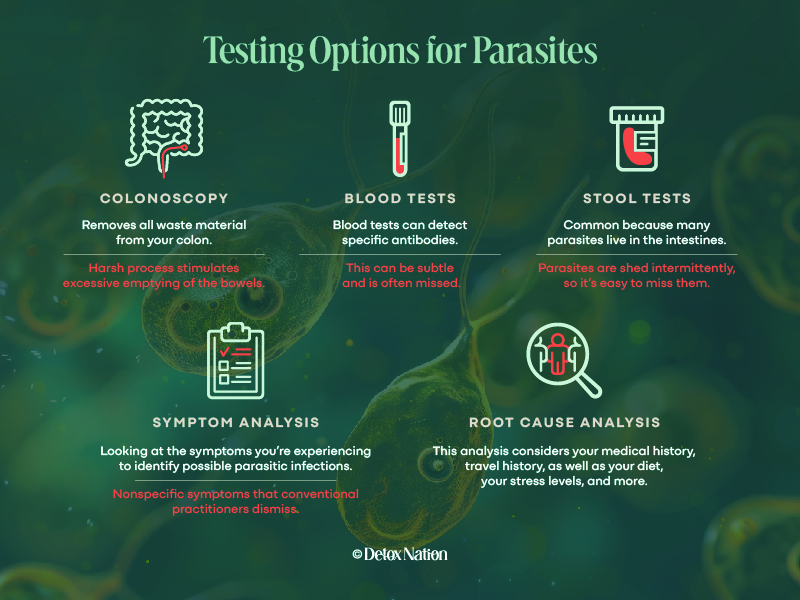
Limitations of Diagnosis and Testing
Diagnosing intestinal worms isn’t as easy as you’d think! They have many tricks to evade detection and each testing method has its limitations.
Starting with Stool Samples
Stool samples can be a common first step in diagnosing intestinal worms.
This test can reveal the presence of eggs, larvae, or adult worms.
But a negative stool test does not mean you’re worm-free.
These tests might not always be accurate because worm eggs might not be present in every sample. This means you might need multiple tests over different days.
Additionally, in the time it takes the stool sample to get to the lab, small worms could die and decompose. (Resulting in a false-negative test.)
The tape test is another method, particularly for pinworms.
It involves pressing a piece of tape against the skin near the anus upon waking to collect eggs, which are examined under a microscope.
Some parasites, like tapeworms or other intestinal worms, might not be detected with these methods.

Beyond the Basics: Imaging and Blood Tests
X-rays, ultrasounds, or even CT scans may help spot larger invaders in the body.
However, these methods aren’t fail-proof. Parasites may go unnoticed if they’re in less visible areas or are too small to detect.
Due to the expense, radiation, and minimal likelihood of success, imaging tests are rarely ordered.
Blood tests can measure eosinophil levels, a type of white blood cell that often increases with parasitic infections.
They might also check for Secretory IgA, an antibody linked to gut issues.
But these tests are indirect; they indicate a problem without specifying a type or location.
Specialized Testing
You might think that a colonoscopy, where a doctor can investigate the intestines with a camera, would be an ideal test to diagnose worm infections.
Sadly (or maybe not sadly?) this is not the case.
During the “prep” for the colonoscopy, worms can “evacuate” the area until the “conditions” return to normal.
Newer PCR tests can identify parasite DNA but can be costly and aren’t widely available.

Why Worm Infections are Often Overlooked
These infections can easily go unnoticed due to various factors. Misdiagnosis can lead you down the wrong treatment path, while silent infections may not show obvious symptoms. Denial and misconceptions about these infections further complicate the issue.
Misdiagnosis
Many chronic infections are often mistaken for other illnesses.
Symptoms like fatigue, rashes, or digestive issues can mimic other common conditions.
Because of this, you may be treated for the wrong thing, leaving the actual infection undiagnosed.
For example, intestinal worms can cause diarrhea, as can many other gastrointestinal disorders
A non-parasite literate practitioner would stop there, and treat the symptom of diarrhea, instead of looking for the underlying cause.
Silent Infections
Intestinal worm infections can be chronic yet silent.
You might carry the infection without showing any obvious symptoms for a long time.
This makes it hard to realize something might be wrong. (It’s not your fault – you weren’t trained to be a “PI” – parasite investigator!)
Conditions like these can persist for years, causing damage slowly over time.
Even when symptoms do appear, they might be mild or nonspecific.
This lack of clear indicators can lead to neglect or incorrect assessments.
Denial
Many people shy away from the idea of parasitic infections due to stigma or embarrassment.
It’s not easy to talk about poop or face the possibility of having worms or other parasites.
This denial can prevent seeking necessary treatment.
Misconceptions lead to thinking these infections only occur in certain regions or among specific groups.
Anyone can be affected, regardless of lifestyle or location.
Let’s normalize talking about poop and parasites!
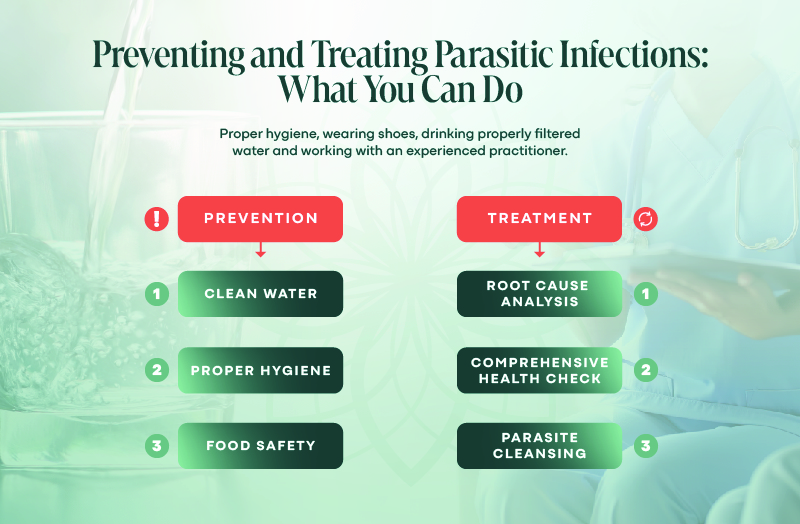
Prevention Is Better Than Cure
To protect yourself from worms, focus on root causes and hygiene.
Root Causes
How could you have been infected with worms?
Did you travel to a region with greater risk? Have you been consuming lots of undercooked foods? Or perhaps not washing your fruits and veggies?
That may be a start…but a healthy body can often resist infection.
Take a moment to ask yourself a better question…“What has disrupted my body’s natural healing process?”
In other words, what has made your body the perfect host to parasitic worms?
Is it your high-stress life? Your reliance on processed foods?
I commonly see parasitic infections in clients who have mold exposure and toxicity.
Next, ask “What does my body want from me so it can be in charge of healing itself again?”
Make that a priority.
At Home: Hygiene and Cooking Practices
Good hygiene is a primary defense against worms.
Always wash your hands with soap after using the bathroom and before eating.
Make sure you use clean water for washing.
Drink distilled water.
Always wash your produce.
When preparing meals, properly cook food, especially meat, to kill any parasites that might be in it.
Conclusion
So, there you have it—worms might actually be the reason you’ve been feeling like death warmed over.
Is it gross? Totally.
But here’s the upside: once you recognize the signs, you’re already on your way to getting rid of them.
Listen to your body, embrace the weirdness, and be relentless about your health.
Because your body is always healing (unless you’re dead, and since you’re reading this, you’re definitely not).
But no one’s going to come along and wave a magic wand to evict these little moochers from your system.
It’s up to you.
The next step?
Take my quick Parasite Assessment Quiz to see if squirmin’ worms might be causing your chronic symptoms.
Take the Parasite Quiz NowFrequently Asked Questions
Worm infections can show up in many ways, like with rashes, stomach pain, or seeing worms in your toilet. People can get worms through various means, including contact with contaminated surfaces or food.
What signs indicate that I might need to deworm?
You might need to deworm if you notice symptoms like itching around the rectum, which is common with pinworms, or if you have stomach pain and a recent travel history to regions where worms are common.
Can you actually see worms in your poop, or are there other things to look for?
Yes, sometimes tiny worms or worm segments might be visible in your poop. However, you should also be aware of indirect signs, like unexplained weight loss or fatigue. If you’re seeing worms, it’s best to consult with a worm-literate provider.
Just wondering, how does one accidentally get worms?
You could accidentally get worms by eating or drinking something contaminated, such as eating raw or undercooked beef, pork, or fish. Walking barefoot on soil that has hookworm larvae is another risk factor. Additionally, touching surfaces with eggs and then putting your hands in your mouth increases your chances of infection.

